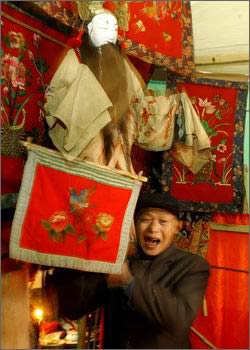 The Northern Qi Dynasty (550-577) witnessed great progress in the manufacture of jointed wooden figures activated by flowing water. In addition, there appeared during that period a puppet show telling the story of Baldheaded Guo. This provides evidence for dating the formation of Chinese puppetry. Records show that puppet shows recounting the story of Baldheaded Guo were performed during the following centuries.
The Northern Qi Dynasty (550-577) witnessed great progress in the manufacture of jointed wooden figures activated by flowing water. In addition, there appeared during that period a puppet show telling the story of Baldheaded Guo. This provides evidence for dating the formation of Chinese puppetry. Records show that puppet shows recounting the story of Baldheaded Guo were performed during the following centuries.
Even today, the puppet show of Heyang in Shaanxi Province has a special character named Laibaozi (a man with a bald head), whose imagery and performance reveal traces of Baldheaded Guo depicted during the Qi and the later dynasties. According to historical texts, we can conclude that puppets manipulated by men were used in China to portray simple stories no later than the Northern Qi period.
The content and form of presentations of Chinese puppetry improved greatly along with the development of other performing arts after the Northern Qi period. During the Sui Dynasty (581-618), jointed wooden figures activated by water were used to depict fairy tales, legends, and stories of the Three Kingdoms. Although they were not puppets manipulated by men, they had a direct influence on the manufacture of puppets and puppet shows. It is a pity that records of them are so sparse.
Puppets activated by water were so ingeniously constructed during the Tang period that they were capable of mimicking human actions such as drinking, singing, and playing the reed pipe. Judging from Tang poems and murals in the No.31 grotto at the Mogao Grottos, string, rod, and glove puppets were already in existence during the Tang Dynasty.
Puppetry was more sophisticated in the Song Dynasty (960-1279) than in the Tang and there is rich recorded information about it. Generally, Song puppetry had four characteristics. First, it widened its scope of subject matter by adapting theatrical plays and stories passed down by storytellers. Second, it had many types of puppets including string, road, water-activated, gunpowder-activated, and human puppets. Third, the manipulative skill was superb and the performance was lifelike. And fourth, a number of master manipulators of string and rod puppets such as Zhang Jinxian and Ren Xiaosan appeared.
